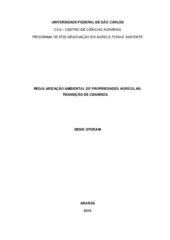| dc.contributor.author | Storani, Denis | |
| dc.date.accessioned | 2016-06-02T18:55:25Z | |
| dc.date.available | 2013-09-09 | |
| dc.date.available | 2016-06-02T18:55:25Z | |
| dc.date.issued | 2013-06-26 | |
| dc.identifier.citation | STORANI, Denis. Regularização ambiental de propriedades agrícolas: transição de cenários. 2013. 141 f. Dissertação (Mestrado em Ciências Agrárias) - Universidade Federal de São Carlos, Araras, 2013. | por |
| dc.identifier.uri | https://repositorio.ufscar.br/handle/ufscar/16 | |
| dc.description.abstract | The constant changes of the forest legislation in Brazil show the complexity in its interpretation and application by the farmers in their properties. Since the first Forest Code (FC) through the decree no. 23.793 from 1934, going through the creation of the New FC through the Federal Law no. 4.771 from 1965 to the Federal Law no. 12.651 from 2012 which formulated the previous one, there were significant changes on the concepts, parameters and on the application way on those standards according to the preservation and the natural sources management of the farms, however, for their regularization should be observed basically two kinds of restriction of the soil usage proposed by the forest law: the permanent preservation area (PPA) and the legal reserve (LR). Thus, the aim of this work was to analyze the transition of the scenes according to the environmental regularization of the farms of the FC from 1965 and FC from 2012, besides to create a timeline from 1934 to 2012, analyzing the main legislations about the creation of the FC diagrams from 1965 and FC from 2012, analyzing the actions which should be done to regulate the farm. It was verified that the FC from 1965 was effective for 47 years, but it had gone through more than 80 modifications in its original text being more constant in the 90 s and 2000 s, nevertheless more than 90% of the farms didn t respect it. The reform of the FC from 1965, consolidated only by the end of 2012 through the Federal Law no. 12.727 which converted the MP no. 571 changing definitely the Federal Law no. 12.651 from May, 25th aimed to modernize trying to pair the FC from 2012 to the new reality of the Brazilian agriculture, bringing new mechanisms and tools to make its application easier. Although these devices should be applied in a practical and simple way to attend the 5.175.636 farms in a two year deadline, taking the risk of disuse like the previous FC. | eng |
| dc.description.sponsorship | Financiadora de Estudos e Projetos | |
| dc.format | application/pdf | por |
| dc.language | por | por |
| dc.publisher | Universidade Federal de São Carlos | por |
| dc.rights | Acesso Aberto | por |
| dc.subject | Direito ambiental | por |
| dc.subject | Código florestal - legislação - Brasil | por |
| dc.subject | Adequação ambiental | por |
| dc.subject | Imóveis rurais | por |
| dc.subject | Forest code | eng |
| dc.subject | Environmental compliance | eng |
| dc.subject | Rural property | eng |
| dc.title | Regularização ambiental de propriedades agrícolas: transição de cenários | por |
| dc.type | Dissertação | por |
| dc.contributor.advisor1 | Colato, Alexandre | |
| dc.contributor.advisor1Lattes | http://lattes.cnpq.br/5460973924624757 | por |
| dc.description.resumo | As constantes mudanças na legislação florestal no Brasil refletem a complexidade na sua interpretação e aplicação por parte dos produtores rurais em suas propriedades agrícolas. Desde o surgimento do primeiro Código Florestal (CF) através do Decreto n0 23.793 de 1934, passando pela criação do Novo CF através da Lei Federal n0 4.771 de 1965 até a Lei Federal n0 12.651 de 2012 que reformou a anterior, houve significativas alterações nos conceitos, nos parâmetros e nas formas de aplicação das referidas normas quanto a preservação e gestão dos recursos naturais nas propriedades agrícolas, sendo que, para a regularização das mesmas, deve-se observar basicamente dois tipos de restrições do uso do solo imposto pela lei florestal: a área de preservação permanente (APP) e a reserva legal (RL). Assim o objetivo deste trabalho foi analisar a transição de cenários nas formas de regularização ambiental das propriedades agrícolas do CF de 1965 e do CF de 2012, além de criar uma linha do tempo de 1934 até 2012 com análise das principais legislações à respeito e a criação dos diagramas do CF de 1965 e do CF de 2012 com análise das ações que devem ser tomadas para regularização da propriedade agrícola. Verificou-se que o CF de 1965 vigeu por 47 anos, mas passou por mais de 80 modificações em seu texto original sendo mais constante na década de 1990 e 2000, e mesmo assim, não foi respeitada por mais de 90% das propriedades agrícolas do País. A reforma do CF de 1965, consolidada somente no final do ano 2012 através da Lei Federal n0 12.727 que converteu a MP n0 571 alterando definitivamente a Lei Federal n0 12 651 de 25 de maio buscou modernizar-se tentando emparelhar o CF de 2012 à nova realidade da agricultura brasileira, trazendo novos mecanismos e ferramentas para facilitação de sua aplicação. Contudo, tais dispositivos deverão ser aplicados de forma prática e simples para atender no prazo de 2 anos os 5.175.636 de estabelecimentos agropecuários, sob risco de cair em desuso como ocorreu com CF anterior. | por |
| dc.publisher.country | BR | por |
| dc.publisher.initials | UFSCar | por |
| dc.publisher.program | Programa de Pós-Graduação em Agricultura e Ambiente - PPGAA-Ar | por |
| dc.subject.cnpq | CIENCIAS AGRARIAS | por |
| dc.contributor.authorlattes | http://lattes.cnpq.br/6384020342617941 | por |
